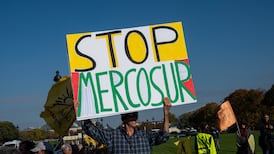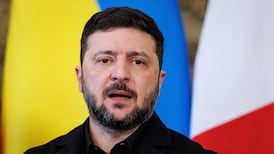Ukraine’s military has announced the start of a counterattack in the south of the country to oust occupying Russian forces, as international inspectors said they would visit a shell-scarred nuclear power plant on the frontline later this week.
“There is news about an offensive along the southern axis, and it has inspired Ukrainians,” Natalia Humenyuk, spokeswoman for Ukraine’s military command in the south, said as heavy explosions were reported on Monday in the cities of Kherson, Melitopol, Nova Kakhovka and other Russian-held parts of the region.
She said Ukraine had “achieved results” in recent weeks by using powerful western rocket systems to strike Russia’s command posts and fuel and arms depots deep inside occupied territory, disrupting its supply lines in the south and east.
“Our actions have weakened the enemy, but they are still very powerful… It is too early to relax,” Ms Humenyuk added.
READ MORE
Kherson regional deputy Serhiy Khlan reported “powerful artillery attacks on enemy positions in … the entire territory of the occupied Kherson region. This is the announcement of what we have been waiting for since the spring – the beginning of the de-occupation of Kherson region.”
Officials in government-held Mykolaiv, about 90km northwest of occupied Kherson, said the centre of the city and residential areas came under heavy Russian rocket fire on Monday afternoon, killing at least two civilians and injuring at least five.
The Russian military did not immediately comment on the developments, but the Moscow-installed head of Crimea – the Black Sea peninsula that the Kremlin annexed in 2014 and which sits to the south of Kherson – dismissed Kyiv’s claims of a counterattack.
Sergei Aksyonov said the reports were “another fake” and insisted that Ukraine’s forces were in fact suffering “very heavy losses in the south and all other areas.”
Two unnamed US officials told CNN that Ukraine had launched “shaping operations” that are typically used to prepare the battlefield and “soften up” enemy positions before a military advance.

Amid reports that Moscow is poised to send reinforcement to the Kherson region, military analyst Rob Lee said on Twitter that “it makes sense for Ukraine to begin shaping operation for an offensive before the Russian 3rd Army Corps arrives and can occupy defensive positions (if that was their purpose)”.
As well as striking Russian supply lines in occupied territory, Ukraine has also used western-supplied rocket systems to badly damage key bridges in the region, and shadowy partisan units have targeted local collaborators: their latest victim appears to be Oleksiy Kovalyov, a Ukrainian deputy turned Russian-appointed official in Kherson, who was found murdered in his home on Sunday.
Russia and Ukraine blamed each other for more shelling close to Europe’s biggest atomic power station, at Enerhodar in the partly occupied Zaporizhzhia region some 200km northeast of Kherson.
Rafael Grossi, director general of International Atomic Energy Agency (IAEA), said a team of its inspectors was travelling to the facility and would be there “later this week”.
Both Kyiv and Moscow say they support the IAEA inspection, but Russia has rejected calls from Ukraine, western states and the secretary general of the United Nations to withdraw its troops and weapons from the site, which it occupied in March.
Damage to power lines temporarily disconnected the plant from Ukraine’s national grid for the first time in its history last week, prompting Kyiv to warn of a potential “radiation disaster” at the six-reactor facility.
(c) Copyright Thomson Reuters 2022















